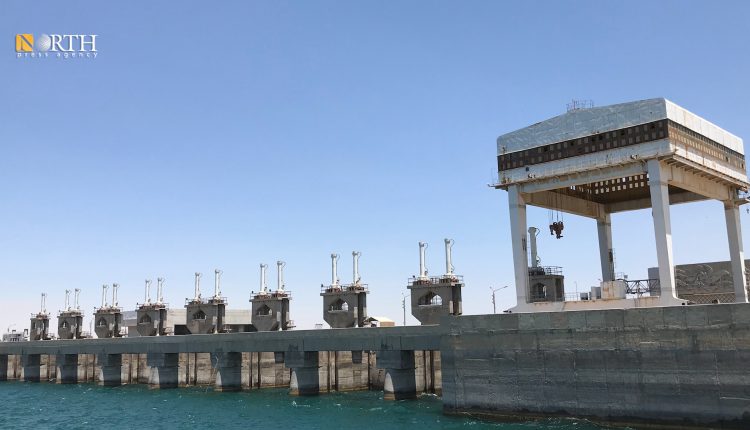AANES issues stark warning about Euphrates water levels dramatic drop
RAQQA, Syria (North Press) – An official of the Autonomous Administration of North and East Syria (AANES) warned on Thursday about the possible complete shutdown of the Euphrates Dam due to the continued decline in water levels.
Imad Obeid, director of the Euphrates Dam, affiliated with the AANES, told North Press that the reservoir lost approximately 5.5 billion cubic meters of its strategic water reserves.
He warned that the continued decline in water levels could lead to the dam’s complete shutdown, with devastating consequences for the region.
Obeid added that the Euphrates reservoir, which has a maximum storage capacity of 14 billion cubic meters, has witnessed an unprecedented drop of seven meters. The water level has fallen from its maximum height of 304 meters above sea level to just 297 meters—posing a severe threat to the dam’s continued operation.
“This is not just a technical issue—it’s a looming humanitarian, social, and environmental crisis,” Obeid said, emphasizing the impact on drinking water, irrigation, and electricity generation.
The water shortage has already caused a significant decline in agricultural production in the region, prompting many farmers to consider abandoning their land and migrating due to water scarcity and increasing financial burdens. Crops that once flourished in the area, such as wheat, barley, sugar beet, corn, and cotton, are now in sharp decline.
Obeid also referenced the 1987 international agreement between Turkey, Syria, and Iraq, which obligates Turkey to release a minimum of 500 cubic meters of water per second to Syria. However, he stated that in recent years, Turkey has been releasing less than 250 cubic meters per second—sometimes even lower—exacerbating the water crisis in Syria.
“As current water losses now exceed incoming flow, the administration has been forced to rely heavily on the dam’s strategic reserves,” Obeid added.
To mitigate the crisis, Obeid urged immediate action, including Turkish compliance with international agreements, investment in alternative energy sources such as thermal, gas, and solar power stations, and the construction of facilities for desalination and water treatment. He also called for increased public awareness to reduce electricity and water consumption and to prevent waste.
He warned that reduced water flow has led to stagnant water conditions, algae growth, and a decline in drinking water quality—resulting in rising cases of hepatitis, poisoning, and acute intestinal infections.
The Euphrates Dam contains eight power-generating units, each with a capacity of 110 megawatts, giving it a total theoretical output of 880 megawatts. However, due to the crisis and war-related damage, only four units are currently operational, and the dam’s production has plummeted.
“In theory, even with four working turbines, the dam should generate around 440 megawatts daily,” Obeid explained. “But due to the low water levels, output has dropped drastically to just 120 megawatts—and is now approaching only 60–65 megawatts.”
He explained that the dam’s turbines operate using Kaplan vertical turbines, which depend on a specific pressure differential between the front and rear water levels. A minimum of 40 meters is required for optimal performance, but the current conditions fall dangerously short.
As a result, power rationing has become necessary, and officials fear the dam could soon cease operations entirely if water levels drop just a few more centimeters.
Obeid concluded by stressing the gravity of the situation, saying the dam’s critical role in the region’s energy, agriculture, and water infrastructure makes immediate international and regional cooperation essential to avoid full-scale catastrophe.

